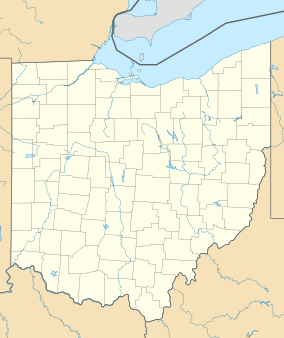Perry's Victory and International Peace Memorial facts for kids
Quick facts for kids Perry's Victory and International Peace Memorial |
|
|---|---|

Perry's Monument as seen from Put-in-Bay harbor in 2012
|
|
| Location | Put-in-Bay, Ohio on South Bass Island, Ohio |
| Nearest city | Port Clinton, Ohio |
| Area | 25.38 acres (10.27 ha) 24.97 acres (10.11 ha) federal |
| Visitors | 155,689 (in 2005) |
| Governing body | National Park Service |
| Website | Perry's Victory and International Peace Memorial |
| Designated | June 2, 1936 |
| Designated | October 15, 1966 (original) April 28, 2015 (increase) |
| Reference no. | 66000118, 15000185 |
Perry's Victory and International Peace Memorial, often called Perry's Monument, is a special place that remembers an important battle and celebrates peace. It stands on South Bass Island, Ohio, near Put-in-Bay, Ohio. This monument honors the Battle of Lake Erie from the War of 1812. In that battle, American Commodore Oliver Hazard Perry led his ships to victory against the British Royal Navy.
The memorial also celebrates the long-lasting peace that has been shared between Britain, Canada, and the United States ever since that war. It reminds everyone that countries can live together peacefully.
Contents
A Towering Monument to Peace
This amazing monument is 352 feet tall. It is the tallest Doric column in the world. A Doric column is a type of ancient Greek column known for its simple design. The monument was built between 1912 and 1915. Its goal was to teach people how countries can solve problems peacefully instead of fighting.
The memorial was designed after a worldwide competition. Joseph H. Freelander and A.D. Seymour created the winning design. The column stands tall over Lake Erie, only five miles from the Canada–United States border.
Who is Honored at the Memorial?
The monument is named after Oliver Hazard Perry. However, six officers who died in the Battle of Lake Erie are buried beneath its floor. Three of these officers were British, and three were American. Commodore Perry himself is buried in Newport, Rhode Island.
Inside the monument, you can see the names of all the soldiers and sailors who were hurt or died in the battle. You can also read the words of the Rush-Bagot Treaty. This treaty helped keep peace between the United States and Great Britain after the War of 1812.
Visiting the Observation Deck
Perry's Monument is the only international peace memorial in the United States National Park System. It is even taller than the Statue of Liberty in New York Harbor. Its top observation deck is 12 feet higher than the Statue of Liberty's torch!
To reach the observation deck, visitors walk up 37 steps. Then, a National Park Ranger takes them up by elevator. From the top, you can see amazing views of Lake Erie and the nearby islands. You can also spot parts of Ohio, Michigan, and even Canada. This includes Middle Island, which is the southernmost point of land in Canada.
History of the Monument
The monument was mostly finished in 1915. However, it took more time to complete the entire memorial area. In 1919, the United States government took over the monument and provided more money. The official dedication ceremony happened on July 31, 1931.
In 2002, a new visitor center was built for $2.4 million. About 200,000 people visit the memorial every year.
Perry's Monument on a US Quarter
Perry's Victory and International Peace Memorial was chosen to represent Ohio in the "America the Beautiful Quarters" series. This series honors a national site from every US state. The coin's design shows Oliver Hazard Perry's statue with the tall International Peace Memorial in the background.
Keeping the Monument Safe
Sometimes, the monument needs repairs to stay safe and strong. For example, in June 2006, a large piece of granite fell from the observation deck. Luckily, no one was hurt. After safety checks, the memorial reopened later that summer.
The monument also closed for repairs in 2009 and reopened in 2012. It closed again in 2017 for more repairs and cleaning.
The old sea wall around the monument was rebuilt between 2022 and 2024. This big project helped protect the monument from the lake.
Boy Scouts and the Memorial
Every year, the monument hosts a large Boy Scout camporee. Troop 360 from Port Clinton, Ohio, organizes this event. Many scout troops camp near the monument grounds. This event is very popular, but sometimes it has to be canceled due to bad weather or flooding.
Images for kids
See also









